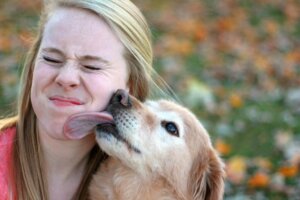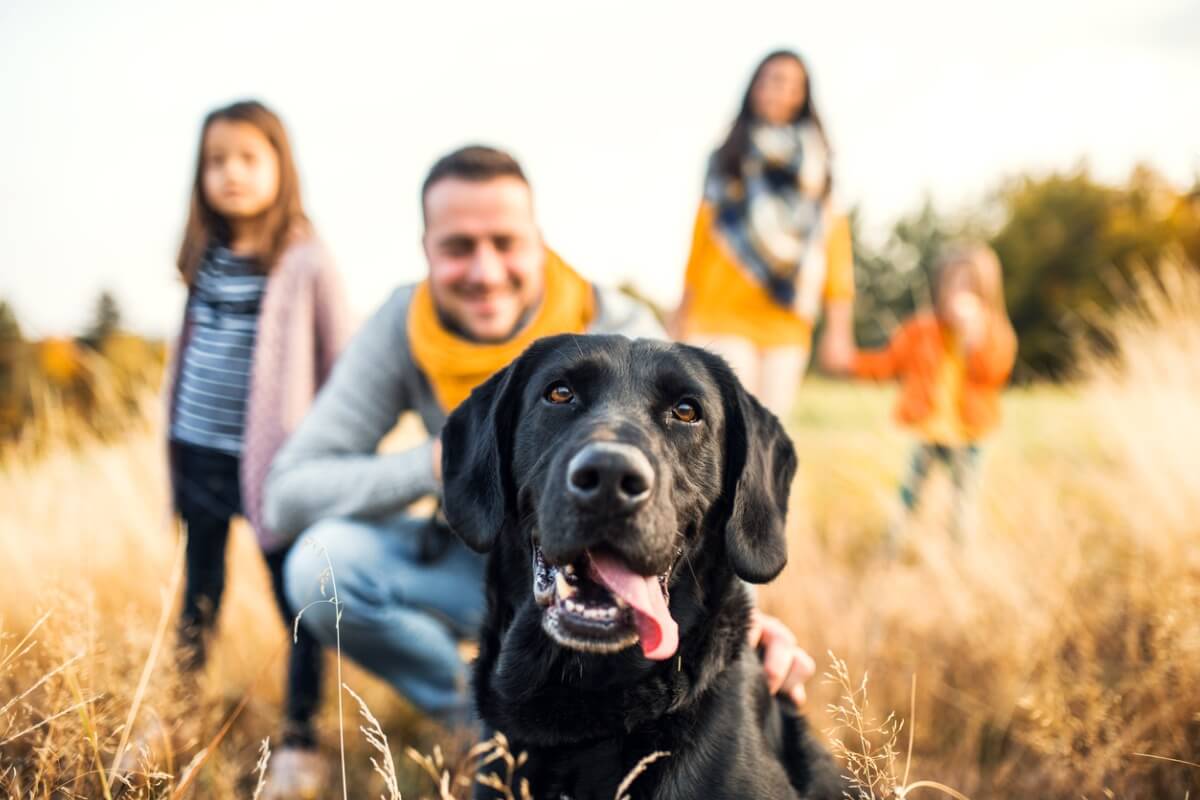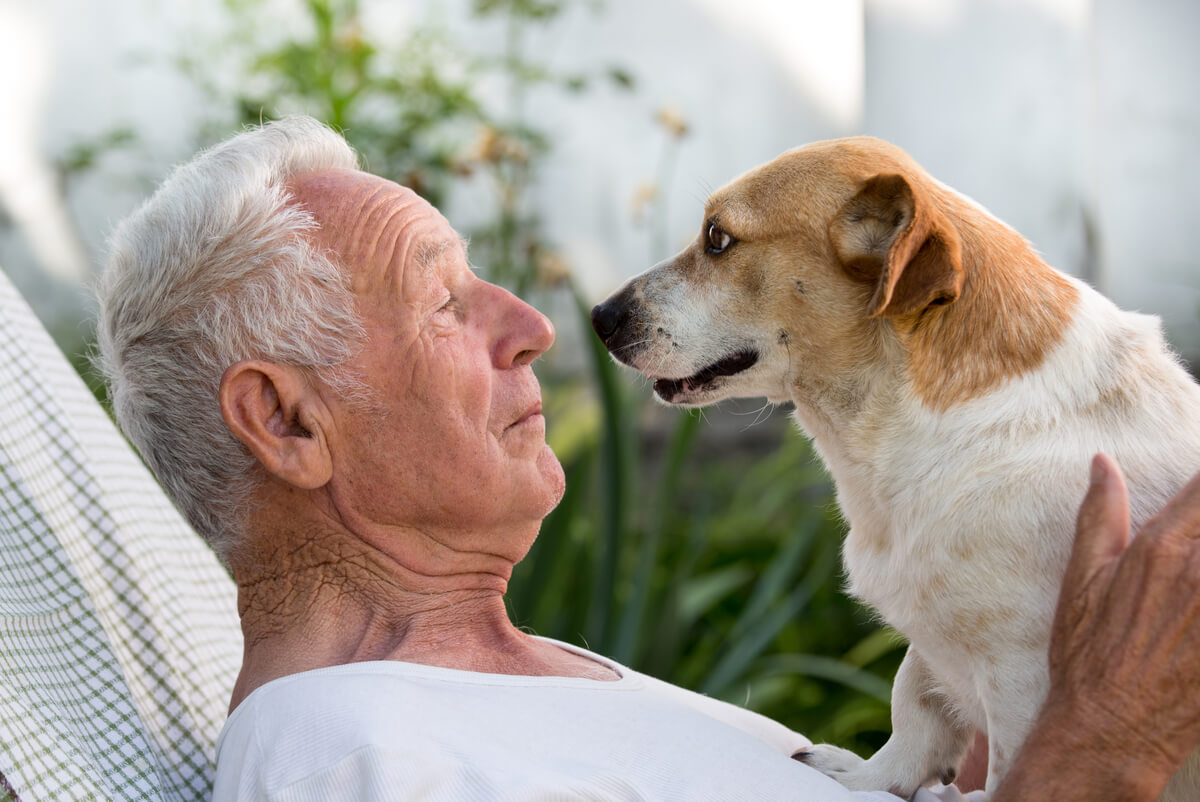How Do Dogs Greet?


Reviewed and approved by the biologist Samuel Sanchez
It’s common for owners to wonder about how dogs greet, and the diversity of expressions that these animals have. You’ll have noticed that, whenever you return home, no matter how long you’ve been away, your dog makes gestures, pirouettes, and a variety of sounds. Sometimes it seems that these reactions don’t have any sort of fixed pattern.
However, this behavior may be different if a different person arrives. This will depend on the body language that the greeted person expresses. This doesn’t mean that the dog isn’t greeting them, but, simply, that it won’t do it in the same way if it doesn’t consider that person to be part of its “pack”.
Keep reading, because in the following article, we’ll tell you how dogs greet humans in a variety of situations. You’ll also discover that their way of expressing themselves will be different even among members of the same species.
How do dogs greet?
A dog’s greeting will depend to a large extent on the confidence that each animal feels for the person or dog to greet. However, canids will always tend to receive a person or another living being because they’re sociable beings by nature.
Articles indicate that dogs, like wolves, have a great social instinct and therefore need to establish order within the pack. In the case of domestic dogs, it’s the adoptive family that assumes the position of the original pack or social group.
Within that social system, codes and languages are established, among which we have their greetings. This gesture usually occurs in the following phases :
- Approach: The dog will approach by creating a curve with his body to let it be known that they’re not looking for trouble, as would be suggested by a straight-line position.
- Inspection: In this phase, the dog will check to see if there are any negative pheromones released in the body odor of the greeted person: fear, nerves, sadness, or jealousy.
- Reaction: Once the dog identifies the attitude of the greeted person, it will react. Depending on the temperament of the animal, it will wag its tail, jump, bark, or move away.

Types of greetings in dogs
There are three different types of greetings in canines, among which the following stand out:
- A greeting between two individuals who know each other and between whom there’s trust and an affective bond.
- The greeting between two dogs that have no bond. For example, between two dogs that barely know each other.
- A dog’s greeting towards people who aren’t part of its pack or who it sees for the first time.
How do dogs greet other dogs?
When they meet, two dogs that know each other start a ritual in which they make gestures and assume body postures that indicate that they are relaxed and feel confident. The guardians will notice that the dogs smell each other, touch each other’s backs, lowering the front part of the body to the ground, while raising their tails to express a desire to play.
Now, when the greeting is given between two dogs that don’t know each other, the ritual is much colder. The gestures that both canids make are somewhat tense. Each dog will be waiting for the response of the other to know if it’s possible to establish a game, and whether their behavior is friendly or not.
In this case, if the encounter occurs between dogs that have had a correct socialization process, the attitude they’ll assume will be friendly. If, on the other hand, there’s a dog with problems in this area, it’ll assume a hostile posture, bark, and let you know that it doesn’t want to share anything with the other.
The role of greetings between dogs
When dogs live in a pack it’s easier to identify the function of the greeting. It’s a gesture that reinforces the hierarchical order established within the social group. Depending on its position, each dog will assume certain behavior patterns of its own.
For example, the submissive dog will always make their submission clear, while the dominant dog will be upright, calm and relaxed. This attitude is easier for humans to identify when a puppy greets an elderly dog.
Of course, studies indicate that this dominance or hierarchy shouldn’t be confused with aggressiveness. It’s simply related to the social status within the pack, not to a position of violence or imposition of fear. The idea of “being the alpha male” has been left behind and disproved by science.
How do dogs greet humans?
The way dogs greet humans includes different gestures depending on the level of confidence they have. In cases where the dog has had problems socializing with people, it can become aggressive. However, we’ll describe the steps that make up the greeting between a dog and a human who have an established bond:
- The dog will jump and turn: The joy of the dog when greeting its human can be such that it will jump and run circles around them.
- It may lie down with its belly up: This is a sign of submission and complete confidence, because the belly is an area of high vulnerability for dogs.
- Licking: The dog will lick the human wherever it can reach, usually the legs, arms, and face.
- Play bites: In addition to licking the human, the greeting will include a kind of play bite in which the dog opens its mouth around some part of the human’s body, but without causing injuries.
- They’ll bring their favorite toy: It’s common for the dog’s greeting ritual to include bringing their favorite toy or object to the person. It may be a ball, a stuffed animal, or food.
- It will bark with emotion: It’s normal for the greeting to include barking and even crying if the dog is really excited. These vocalizations always come mixed with some of the behavior described.
How to greet dogs?
The way a human greets a dog will often depend on whether they know it or not. When it comes to greeting an unfamiliar dog, it’s best to observe it, to identify whether or not they seem willing to socialize. If the dog shows receptivity, proceed with caution, but don’t show fear.
When approaching an unfamiliar dog, it’s necessary to convey security and confidence, avoiding very sudden movements or sounds that confuse the dog.
If the dog keeps its distance, it’s best to respect its space and wait a while. On the other hand, regardless of whether the dog looks receptive or not, let it sniff you and get closer, but don’t touch it if you’re not sure of its reaction.
When it comes to greeting the family dog or another dog you know, there are no limits. When there’s trust and confidence with the dog concerned, you can pet it, pick it up, give it kisses and play, all depending on the moment.
If a dog shows anxiety or stress when greeting people, then we recommend that you go to an ethologist or expert in behavior. Only then can a work plan be established that includes greeting guidelines that don’t reinforce negative behavior.

How to teach him to greet dogs?
Dogs often learn to say hello during the socialization stage with their siblings and their mother. When this doesn’t happen and the canid is separated too early from its litter, these guidelines should be taught at home.
As with separation anxiety, the ideal thing is to go to a canine professional or educator to identify what’s wrong in your greeting ritual and correct it in a timely manner. A well-behaved dog will greet you with all the joy in the world and will make you happy every day of your life.
It’s common for owners to wonder about how dogs greet, and the diversity of expressions that these animals have. You’ll have noticed that, whenever you return home, no matter how long you’ve been away, your dog makes gestures, pirouettes, and a variety of sounds. Sometimes it seems that these reactions don’t have any sort of fixed pattern.
However, this behavior may be different if a different person arrives. This will depend on the body language that the greeted person expresses. This doesn’t mean that the dog isn’t greeting them, but, simply, that it won’t do it in the same way if it doesn’t consider that person to be part of its “pack”.
Keep reading, because in the following article, we’ll tell you how dogs greet humans in a variety of situations. You’ll also discover that their way of expressing themselves will be different even among members of the same species.
How do dogs greet?
A dog’s greeting will depend to a large extent on the confidence that each animal feels for the person or dog to greet. However, canids will always tend to receive a person or another living being because they’re sociable beings by nature.
Articles indicate that dogs, like wolves, have a great social instinct and therefore need to establish order within the pack. In the case of domestic dogs, it’s the adoptive family that assumes the position of the original pack or social group.
Within that social system, codes and languages are established, among which we have their greetings. This gesture usually occurs in the following phases :
- Approach: The dog will approach by creating a curve with his body to let it be known that they’re not looking for trouble, as would be suggested by a straight-line position.
- Inspection: In this phase, the dog will check to see if there are any negative pheromones released in the body odor of the greeted person: fear, nerves, sadness, or jealousy.
- Reaction: Once the dog identifies the attitude of the greeted person, it will react. Depending on the temperament of the animal, it will wag its tail, jump, bark, or move away.

Types of greetings in dogs
There are three different types of greetings in canines, among which the following stand out:
- A greeting between two individuals who know each other and between whom there’s trust and an affective bond.
- The greeting between two dogs that have no bond. For example, between two dogs that barely know each other.
- A dog’s greeting towards people who aren’t part of its pack or who it sees for the first time.
How do dogs greet other dogs?
When they meet, two dogs that know each other start a ritual in which they make gestures and assume body postures that indicate that they are relaxed and feel confident. The guardians will notice that the dogs smell each other, touch each other’s backs, lowering the front part of the body to the ground, while raising their tails to express a desire to play.
Now, when the greeting is given between two dogs that don’t know each other, the ritual is much colder. The gestures that both canids make are somewhat tense. Each dog will be waiting for the response of the other to know if it’s possible to establish a game, and whether their behavior is friendly or not.
In this case, if the encounter occurs between dogs that have had a correct socialization process, the attitude they’ll assume will be friendly. If, on the other hand, there’s a dog with problems in this area, it’ll assume a hostile posture, bark, and let you know that it doesn’t want to share anything with the other.
The role of greetings between dogs
When dogs live in a pack it’s easier to identify the function of the greeting. It’s a gesture that reinforces the hierarchical order established within the social group. Depending on its position, each dog will assume certain behavior patterns of its own.
For example, the submissive dog will always make their submission clear, while the dominant dog will be upright, calm and relaxed. This attitude is easier for humans to identify when a puppy greets an elderly dog.
Of course, studies indicate that this dominance or hierarchy shouldn’t be confused with aggressiveness. It’s simply related to the social status within the pack, not to a position of violence or imposition of fear. The idea of “being the alpha male” has been left behind and disproved by science.
How do dogs greet humans?
The way dogs greet humans includes different gestures depending on the level of confidence they have. In cases where the dog has had problems socializing with people, it can become aggressive. However, we’ll describe the steps that make up the greeting between a dog and a human who have an established bond:
- The dog will jump and turn: The joy of the dog when greeting its human can be such that it will jump and run circles around them.
- It may lie down with its belly up: This is a sign of submission and complete confidence, because the belly is an area of high vulnerability for dogs.
- Licking: The dog will lick the human wherever it can reach, usually the legs, arms, and face.
- Play bites: In addition to licking the human, the greeting will include a kind of play bite in which the dog opens its mouth around some part of the human’s body, but without causing injuries.
- They’ll bring their favorite toy: It’s common for the dog’s greeting ritual to include bringing their favorite toy or object to the person. It may be a ball, a stuffed animal, or food.
- It will bark with emotion: It’s normal for the greeting to include barking and even crying if the dog is really excited. These vocalizations always come mixed with some of the behavior described.
How to greet dogs?
The way a human greets a dog will often depend on whether they know it or not. When it comes to greeting an unfamiliar dog, it’s best to observe it, to identify whether or not they seem willing to socialize. If the dog shows receptivity, proceed with caution, but don’t show fear.
When approaching an unfamiliar dog, it’s necessary to convey security and confidence, avoiding very sudden movements or sounds that confuse the dog.
If the dog keeps its distance, it’s best to respect its space and wait a while. On the other hand, regardless of whether the dog looks receptive or not, let it sniff you and get closer, but don’t touch it if you’re not sure of its reaction.
When it comes to greeting the family dog or another dog you know, there are no limits. When there’s trust and confidence with the dog concerned, you can pet it, pick it up, give it kisses and play, all depending on the moment.
If a dog shows anxiety or stress when greeting people, then we recommend that you go to an ethologist or expert in behavior. Only then can a work plan be established that includes greeting guidelines that don’t reinforce negative behavior.

How to teach him to greet dogs?
Dogs often learn to say hello during the socialization stage with their siblings and their mother. When this doesn’t happen and the canid is separated too early from its litter, these guidelines should be taught at home.
As with separation anxiety, the ideal thing is to go to a canine professional or educator to identify what’s wrong in your greeting ritual and correct it in a timely manner. A well-behaved dog will greet you with all the joy in the world and will make you happy every day of your life.
All cited sources were thoroughly reviewed by our team to ensure their quality, reliability, currency, and validity. The bibliography of this article was considered reliable and of academic or scientific accuracy.
- Milocco, S., Dragonetti, A. Comportamiento normal y ontogenia de la conducta en caninos. Revista del colegio 34.
- Teoría de la dominancia en perros. Asociación de Veterinarios Españoles Especialistas en Pequeños Animales (A.V.E.P.A)
- Fisiopatología, diagnóstico y tratamiento de la ansiedad por separación en el perro. Clin. Vet. Peq. Anim., 26 (4): 329-334, 2006
This text is provided for informational purposes only and does not replace consultation with a professional. If in doubt, consult your specialist.








